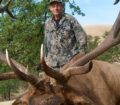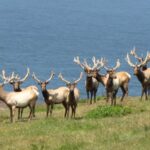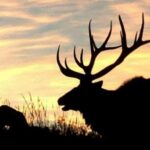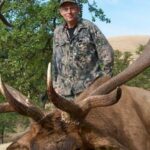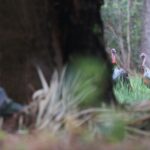Editor’s Note: In the turkey-hunting fraternity, one of the toughest turkeys to take in the Continental U.S. is the Osceola gobbler. Actually hunting the Osceola isn’t any different from hunting any other turkey; however, the area where he lives in Florida is very small. Although, there’s some public hunting for the Osceola, it’s fairly well restricted. The same is true about the Roosevelt elk and even more so the Tule elk. California is the only state that has both the Roosevelt and the Tule, as well as the Rocky Mountain elk. JITW wanted to take a closer look at these far western elk, and what’s required to take them.

So, we talked to Parrey Cremeans, a hunting guide from northern California, who has been hunting and guiding n the far west since 1988. His guiding service is called Just For Hunting, which you can find online at, and hi phone number is: 650-888-0808. He’s taken several elk and called in many more for his clients, besides guiding for black-tailed deer, mule deer, antelope, turkeys (Rio Grande and Merriam’s gobblers), bear, black bears and hogs. Or, to learn more about hunting elk specifically, you can find more information here. If you’re interested in hunting any one of these three elk subspecies, you need to book a hunt about two years in advance or even earlier than that. Here’s a map of California’s Elk Hunt Zones.
Our elk in Northern California range from the Cascade Mountains west to the Coastal Mountains. Sometimes when you’re hunting these elk, you’ll see them laying down on a sandy beach with the ocean behind them. But the toughest hunt I’ve been on was when I guided my friend, Jason, from Oregon. We were hunting in clear-cuts where regrowth timber was planted after a clear-cut. These areas were really thick and steep. Although we were following a herd of elk that was walking away from us, they would respond some to our calling. After a while, we finally got one bull to turn around and come to us. I was calling 60-80 yards behind Jason, who would be the shooter.
One of the reasons I like to get that far behind my shooter is because when a Roosevelt elk comes in during the rut, he’s coming in to fight. So, the first thing he normally will do is to circle downwind of where the call’s coming from to make sure that the bull he hears calling him isn’t a bull that’s already beaten him up in a fight. By placing my shooter 60-80 yards in front of me, the shooter should see the elk and get a shot before the Roosevelt circles downwind of the caller. Roosevelt elk usually make a lot of noise coming in, and if a bull sees you, you still may have a small chance of getting a shot. But if the elk smells you, he’s gone, and the hunt is over.
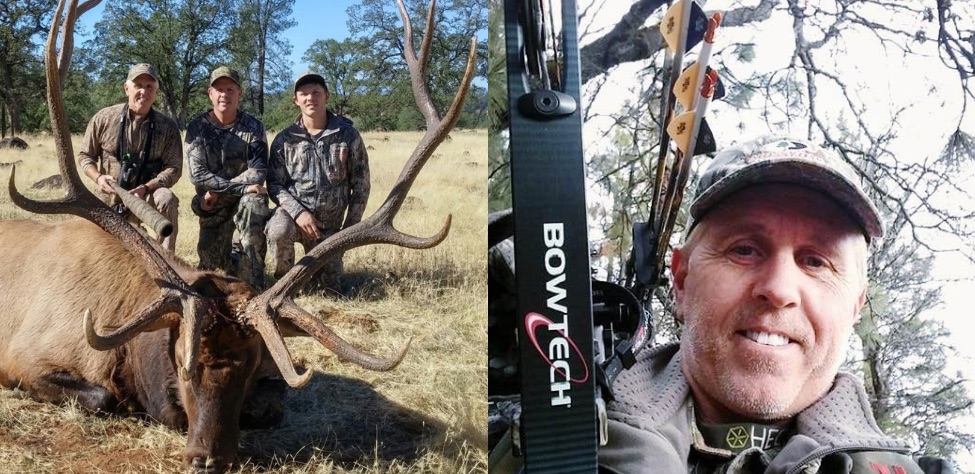
This Roosevelt bull Jason and I were hunting was so mad that he came in charging. Jason took the shot with his bow at 17 yards. His arrow flew true and hit the elk right behind the shoulder. After the shot and all the high fives and congratulations were over, we waited about 45 minutes before we started following this elk’s blood trail. We were pretty confident that the elk didn’t go very far, and that Jason had made a good, lethal hit on that bull. We found the elk at about 3:00 pm. The bull was a big 5X5.
Since much of the Roosevelt elk’s habitat is full of very-tall trees providing shade, we were able to butcher the elk, break him down and carry two daypacks of meat back to the truck before dark. The pack I use is from a brand called Stone Glacier. I like this pack because it has a really-big main compartment that’s not shelved, which allows you to put a lot of meat in that compartment. Then it opens-up and has a shelf behind the main pack where you can tie on more meat. However, we still couldn’t fit all that meat in our packs in one trip, so we took what we could and tied up the rest of the meat in trees to keep predators from getting to it.
The next morning, we got up early, took our empty frame packs,made two trips that day and then made two more trips the next day to get all the meat out. So, after the bull was shot required two more days for us to finally get all the meat back to the truck. Our truck was only parked 3/4-mile or so from where this bull was taken. However, the mountains we had to climb were straight-up and straight-down. Even if you’re in very-good shape for a Roosevelt elk hunt, when you have to pack out that much weight and go straight-up and straight-down mountains,you’ll be worn out when you get back to the truck with each load. Every trip we had to pull ourselves up through the brush carrying 80-100 pounds of boned-out meat. The quarters on that elk weighed about 135-pounds each. A Rocky Mountain elk quarter usually will weigh 85-100 pounds for a bull scoring about 275 – 282 on Boone & Crocket (B&C).
Looking for more content? Check out our YouTube channel and watch “The Difference Between Contest Calling and Hunting Calling” by John E. Phillips.
Expert Guidebooks on Elk Hunting: Best Sellers

Secrets for Hunting Elk
The quickest, easiest (if there is an easy way), and safest way to find and take that bull elk of a lifetime will be to hunt with a guide.
Chad Schearer, a longtime Montana guide and TV personality, told me, “My hunter is my gun. If I get to the elk, and my hunter isn’t with me, then we don’t take the elk. My job is not only to find the elk but also to help the hunter get to the elk and make the experience as enjoyable as I can for him.” That’s the kind of fella with whom I want to go elk hunting.
An elk hunt can be tough, but it doesn’t have to be so tough that you don’t enjoy it. That’s why this elk hunting book starts with the confessions of an elk guide and with Chad Schearer’s philosophy of what the guide and the hunter’s relationship should be.
A good portion of your success will depend on your physical condition, and Matt Morrett of Harrisburg, Pennsylvania explains how an eastern hunter can get ready physically during June and July to hunt western elk, the animals he describes as, “Like deer or turkeys on steroids.”
Wayne Carlton, well-known elk hunter and TV and video personality from Montrose, Colorado, tells us what types of elk calls to use and what to say to the elk. Mike Miller of Colorado, another elk guide and Mossy Oak video personality, has tactics for the best equipment for bowhunting and gun hunting elk.
You’ll learn helpful strategies and hunting tips in this book, as well as some straightforward hunting methods that will help to make your elk hunt more successful.
“Thanks to the advice in your elk hunting books, I was able to call up a nice 6-point (6X6) bull elk! He was bugling like crazy. I called him in from about a ¼ mile away. Called him into bow range (about 40 yards away). It was a thrill!” ~Rob Brannon
VERSIONS: AUDIBLE & KINDLE

Elk: Keys to 25 Hunters’ Success
Often just one tip or tactic makes the difference in whether you take an elk home to dinner or have to hike back to the truck by yourself. In John E. Phillips’ latest elk book, Elk: Keys to 25 Hunters’ Success, you’ll learn from successful elk hunters the strategies they use to find and take elk.
Many know that the technique that seems to work most often is to hunt where other elk hunters don’t and understand where the elk are before you go on a hunt by studying data from each state, visiting HuntData (see chapter 1), examining maps, and reading postings on elk forums.
This book also tells you how to get ready physically for an elk hunt, including participating in Train to Hunt Competitions, what gear you need to take, how to enjoy a successful do-it-yourself elk hunt, or how to pick the best elk guide for you. You’ll also hear about the X System and the Broken Y System of hunting elk.
Although no one person has all the answers on how to help you find and take your elk, I’m convinced that this book’s outdoors men and women will teach you how to have satisfying elk hunts.
As my friend Karl Badger once told me, “Elk hunting doesn’t get any better than when I ride horses into the high backcountry, see two grizzly bears, hear a pack of wolves howl close to camp all night long, eat plenty of delicious food prepared on a fire and enjoy the company of good friends.”
VERSIONS: AUDIBLE, KINDLE & PRINT

How to Find Your Elk and Get Him in Close will teach you the tactics of 10 nationally known elk hunters, to help put that giant bull that’s been screaming at you from afar, in your lap. You’ll learn what some of the best guides, outfitters, and successful elk hunters do to find elk and get them in really close.
Also in this audiobook, you’ll notice that the majority of the experts call elk to within bow range. We selected numerous bowhunters and bowhunting guides, since the bowhunter has to get much closer to a bull than the gun hunter does – often less than 20 or 30 yards – practically in your lap.
On one elk hunt, I’d heard this bull bugle all morning. My guide had called him within 30 yards, and he was standing just inside black timber. I saw the smoke from his nose wafting out into the icy air less than 30-yards away. All the bull had to do was step out, and I could take the shot with my bow. But then, through no fault of my guide or me, the bull vanished.
The only conclusion I could come up with to understand why the bull I wanted to take with my bow hadn’t stepped out and given me a shot, was because he got raptured. He evidently had left the earth with no trace of himself.
This hunt was when I started wanting to learn more about hunting elk up close. In this book, I’ve tried to find some of the most knowledgeable, experienced, and practical elk hunters. I’ve always found that the best way to learn any outdoor skill, is to either hunt or fish with the best sportsmen in that field.
Often, in elk hunting, that means elk guides, who generally hunt every day of the season and receive a salary for every hunter they guide. So, I’ve put together a group of some of the best elk hunters I know to help us all learn how to find bull elk and get them in close.
VERSIONS: AUDIBLE, KINDLE & PRINT
Tomorrow: : Taking a Roosevelt Elk Isn’t Guaranteed


